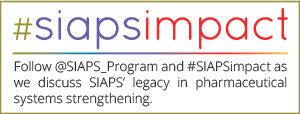By Helena Walkowiak and Maura Soucy Brown
In SIAPS’ upcoming webinar on defining and measuring pharmaceutical systems strengthening (PSS), we’ll talk briefly about the development of a new tool that SIAPS and its partners are piloting. It’s intended to help the field measure the impact of PSS efforts.
Some background on this activity: SIAPS has been using a systems strengthening approach since 2011 to help low- and middle-income countries improve access to and use of effective, quality-assured pharmaceutical products and services. Although global health workers and governments need to effectively capture and communicate the impact of our investments in strengthening health systems, there is no standard approach for measuring progress in strengthening pharmaceutical systems. Plus, there has been no widely accepted definition of what constitutes a pharmaceutical system, let alone what it means to make it stronger and more resilient.
Without tools for measuring progress, countries and donors don’t have enough information to effectively direct interventions and investments. Attempts to measure individual aspects of pharmaceutical systems—such as supply chains or patient services—without looking at how they are interrelated or inspecting behind-the-scenes support structures, such as governance and financing, can lead to the inefficient use of resources and interventions that fail to deliver broad, replicable results. Such investigations might turn up efforts that improve the performance of certain aspects of the system for a time, but long-term outcomes are difficult to predict without accounting for system interactions and holistic performance.
Defining systems and components for measurement
As part of its vision for health systems strengthening, USAID’s Office of Health Systems asked SIAPS to develop a framework to measure progress in pharmaceutical systems strengthening: lasting results that improve a system’s performance and resiliency over the long term. SIAPS held a consultative meeting in 2014 with our partners and WHO to settle on the components, performance attributes, and outcomes that are important to include in the PSS measurement framework. Participants identified seven high-level components that are critical to track: policy, law, and governance; regulatory systems; pharmaceutical products and services; human resources; financing; information; and innovation, research and development, manufacturing, and trade.
Based on that meeting, we have proposed definitions of a pharmaceutical system and pharmaceutical systems strengthening. (Here’s an article in Health Policy and Planning that presents these definitions and the methodology used.)
PSS Insight
Along with SIAPS colleagues Ruth Musila and Francis Aboagye-Nyame, we’ve also developed a new data collection and management tool for monitoring PSS. The tool, called PSS Insight, uses both existing and new indicators to provide a comprehensive, high-level picture of PSS efforts. It can help highlight system strengths and weaknesses, identify areas for scrutiny and diagnosis, and help national governments and donors allocate funding and support in areas that may benefit from further strengthening.
 The tool is based on the above seven components of the PSS measurement framework. Each component comprises several elements. For each element, associated indicators were selected and/or developed to build a tool that would measure the current state of the pharmaceutical system. To date, the tool includes 27 elements and 115 indicators.While the framework is arranged according to pharmaceutical system components for measurement, users can customize assessments by digging deeper into specific components and elements within the pharmaceutical system. Health ministries can use it as a score card to periodically gather evidence to assess progress nationally over time or for regional comparisons. The tool is also unique in that it incorporates some initial measures of system resilience. However, these indicators will need to be tested and validated before they can be used to provide information on a pharmaceutical system’s capacity to withstand or adapt to challenges such as public health emergencies.
The tool is based on the above seven components of the PSS measurement framework. Each component comprises several elements. For each element, associated indicators were selected and/or developed to build a tool that would measure the current state of the pharmaceutical system. To date, the tool includes 27 elements and 115 indicators.While the framework is arranged according to pharmaceutical system components for measurement, users can customize assessments by digging deeper into specific components and elements within the pharmaceutical system. Health ministries can use it as a score card to periodically gather evidence to assess progress nationally over time or for regional comparisons. The tool is also unique in that it incorporates some initial measures of system resilience. However, these indicators will need to be tested and validated before they can be used to provide information on a pharmaceutical system’s capacity to withstand or adapt to challenges such as public health emergencies.
PSS Insight is an Excel-based tool now, but it will eventually be web based for easy data entry and reporting. We’ve piloted the tool in Bangladesh and are currently piloting it in Namibia, and it is expected to be rolled out to USAID Global Health priority countries. SIAPS plans to finalize the tool and accompanying user manual in early 2018. As SIAPS concludes its technical activities over the next few months, we will continue to assess and communicate our impact and lessons learned. (Follow us @SIAPS_Program, #SIAPSimpact.)


